Alexandre Benois: a short biography and creativity. Alexander Nikolaevich Benois biography
He is an ambiguous figure, Alexandre Benois. The Academy of Arts seemed to him too official. "New Art" at first aroused indignation, later he tried to understand it, on the question of "understood" opinions differ. He was blamed for the refinement of the paintings and at the same time collaborated with the Soviet authorities. He painted portraits about the era of Paul I and Louis XIV (“escaped to Versailles!”), but in the turbulent years of 1917-1920 he saved and collected the treasures of the Hermitage and the Russian Museum.
Alexander Benois Born in the family of a Russian nobleman of French origin, Nikolai Benois (chief architect of Peterhof) and the daughter of Italian architect Albert Cavos, Camilla. The cult of the arts reigned in the family. Alexander's older brother Albert was a watercolorist, another brother, Leonty, was an architect. Both taught at the Academy of Arts. Sister Ekaterina married the sculptor Eugene Lansere. Her children, the artists Nikolai and Yevgeny Lanceray, and her daughter, the well-known artist Zinaida Serebryakova, were Alexander Benois' nephews.
Alexander Benois was married to his sister-in-law - his brother Albert married Maria Kind, and Alexander noticed the younger Anna. At the age of 15, he confessed his love to her. Albert and Maria divorced after some time, and Alexander and Atya, as her family called her, stopped communicating, but they did not last long. Soon, the young people began dating again, and after graduating from the university, Alexander Benois married Anna, who became his faithful friend and beloved woman for life.
He entered the Academy of Arts in 1887 and studied for four months, which he later referred to as wasted time. Teaching seemed boring to him, and his main result was the conclusion that painting cannot be learned by listening to lectures. Thus, an end was put to academic art education, and Benois entered the law faculty of St. Petersburg University.
He quit attending the Academy of Arts, but at the same time he really became interested in art. It turned out that he has a talent that is far from always combined with a talent for painting: Alexandre Benois was very good at "talking about it." It revealed the desire to instruct, share knowledge, reveal the background of the artistic process. Moreover, to do it in such a way that others wanted to be near, participate and “surround”. Thus, the “Benoit Circle” was organized, which included people who in the future had a considerable influence on Russian art, including the artist Leon Bakst. Members of the circle proclaimed German symbolists Arnold Böcklin, Max Klinger, Adolf von Menzel as idols in painting.
The matter was not limited to oral conversations; Alexandre Benois began his career as an art historian by writing an article about Russian artists in 1894 for Richard Muther's German collection "History painting XIX century."
In 1896, Benois, together with Leon Bakst and Konstantin Somov, came to France, where he immersed himself in the study of the history of French art. In society, an era of disappointment in realism is coming, and Benoit is trying to decide on his attitude to the new painting. He is attracted by the Impressionists Monet and Degas. But in general, he is repelled by incomprehensible tendencies. “Symbolists and decadents went bankrupt, promised a lot, gave some scratches”, — this is how Benoit describes his attitude to modernism.
It is known that Ilya Repin spoke commendably about Benois, noting that his watercolors are deep, fresh, and strong. However, it is no less known that Repin in general at that time was extremely supportive of novice artists. It was later that he would not spare the representatives of the "new art". David Burliuk in his manifesto “The Noisy Benois and the New Russian National Art” even contrasts Repin and Benois, stating that Repin scolds and hates sincerely, and Benois tries to “fit in and praise”, surreptitiously trampling into the mud.
Fame for Benois as an artist came after two cycles: Versailles and Russian. His favorite direction was the reconstruction of historical subjects. Themes closest to Alexandre Benois - Petersburg XVIII- early XIX century" and France of Louis XIV. They are revealed in the Versailles series of 1897 and 1905-1906 and the paintings "Parade under Paul I", "Peter the Great, thinking about the construction of St. Petersburg" and others. Benoit was able to surprisingly accurately reproduce the color and style era.
In 1898, the Benois circle published the first issue of the World of Art magazine. The magazine called for progress and renewal, but at the same time actively fought against the Wanderers and modernism. In 1904, due to disagreements, the publication was closed. During this time, Benois wrote The History of Russian Painting in the 19th Century. The main direction of the book is the preservation of the traditions of Russian art. “The point is not at all in the search for something new, but in building from what is found”, - so he formulates one of his principles. Also in the book, the contribution to Russian painting by Kiprensky, Venetsianov, Bakst, Somov is appreciated. This edition was published in 1902 and aroused the liveliest and ambiguous interest of contemporaries. Researchers note the inconsistency of the presentation: Benoit actively denies the programmatic nature of art, but at the same time he himself puts forward programmatic guidelines for its evaluation.
In 1910, Alexander Benois organized the World of Art society in St. Petersburg. Nicholas Roerich became its first chairman. The central aesthetic idea is the special mission of Russian painting and ... utopian inclusiveness. I wanted to “unite and reconcile” everyone. Unlike the magazine, the World of Art society does not fence itself off from the fact of the existence of new trends and young artists: the exhibitions feature paintings by Goncharova and Larionov, Lentulov and Saryan, Petrov-Vodkin and Konchalovsky. Benois suddenly discovers that this is not such a “daub”, for which he is repeatedly mentioned in the manifesto of Burliuk with accusations of snake cunning. Of particular note is the cardinal change in Benoit's attitude towards the work of Natalia Goncharova. If at first he makes sarcastic, sarcastic jokes about her, then later he admits that “it is not necessary to teach Goncharov, but to learn from her.”
Benoit was an excellent illustrator. The ABC in Pictures by Alexandre Benois gained wide popularity. He also illustrated two editions of Alexander Pushkin's The Queen of Spades and three versions of his The Bronze Horseman.
A gigantic revolutionary utopia was unfolding in public life, and in the cultural sphere of the now Soviet Union, the attempt to organize an aesthetic utopia in which there was enough room for everyone was failing. Modernism, having escaped from the captivity of oppression, seized the reins of government, and now it has become unsuitable to be a realist. "Many gifted painters were ashamed of their realistic" manners ", hiding simple, healthy sketches from prying eyes and exposing only experiments on cubic deformations of nature, newspaper stickers and similar nonsense", writes Benoit about this period.
The artist feels sympathy for the Bolsheviks, which is why he loses the favor of his former friends and colleagues. The new government enlists him to protect art treasures from vandalism. Since 1918, Benois has been in charge of an art gallery in the Hermitage and selects from private collections collected in the palaces of Tsarskoye Selo and Peterhof, which have become folk paintings for museums. Largely thanks to Benoit, the Hermitage and the Russian Museum have survived intact and safe to descendants.
In 1926, Benois left for France, where he held his first and last solo exhibition. It is not known whether he planned, when leaving, not to return to his homeland, or decided this in Paris. But his refined art was very, very far from the ideals of the revolution. Probably, he has already fulfilled his historical mission of preserving paintings for the Hermitage.
It is known that for the rest of his life Benoit yearned for Russia. France never became his second home. “We are not at home,” he wrote with pain in his memoirs.
Benois Alexander Nikolaevich (1870-1960) graphic artist, painter, theater artist, publisher, writer, one of the authors of the modern image of the book. Representative of Russian modernity.
A. N. Benois was born into the family of a famous architect and grew up in an atmosphere of reverence for art, but did not receive an art education. He studied at the Faculty of Law of St. Petersburg University (1890-94), but at the same time independently studied the history of art and was engaged in drawing and painting (mainly watercolor). He did this so thoroughly that he managed to write a chapter on Russian art for the third volume of "The History of Painting in the 19th Century" by R. Muther, published in 1894.
They immediately started talking about him as a talented art critic who turned over the established ideas about the development of domestic art. In 1897, based on impressions from trips to France, he created the first serious work - a series of watercolors "The Last Walks of Louis XIV", showing himself in it as an original artist.

The last walks of Louis XIV
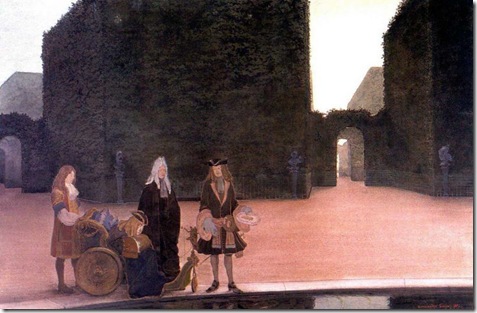
Masquerade under Louis 14. 1898

Walk of the King. 1906
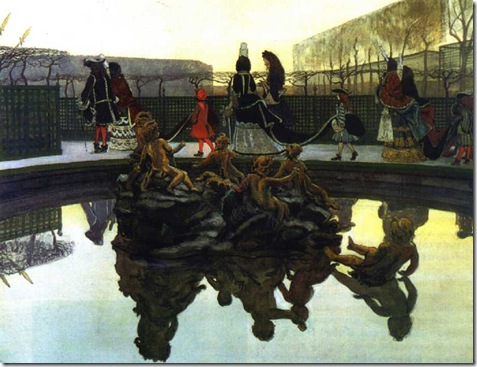
from the series "The last walks of Louis 14". 1898
![]()
Repeated trips to Italy and France and copying artistic treasures there, studying the writings of Saint-Simon, Western literature of the 17th-19th centuries, and interest in ancient engravings were the foundation of his artistic education. In 1893, Benois acted as a landscape painter, creating watercolors of the environs of St. Petersburg. In 1897-1898 he paints in watercolor and gouache a series of landscape paintings of the Versailles parks, recreating in them the spirit and atmosphere of antiquity.
Versailles. 1906
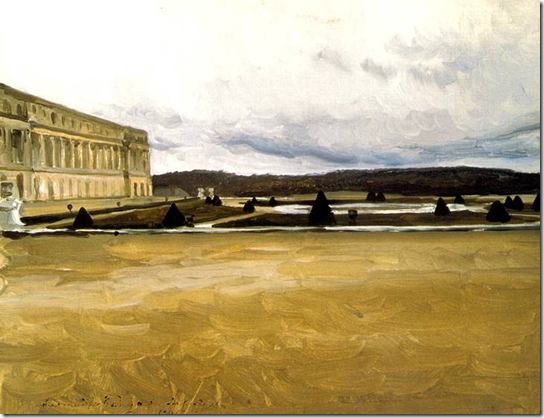
Versailles. Trianon Garden. 1906
![]()
Versailles. Alley. 1906

Name of the painting: Cemetery. 1896-97
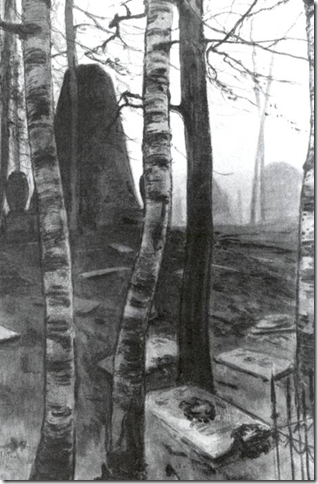
Name of the painting: Carnival on the Fontanka
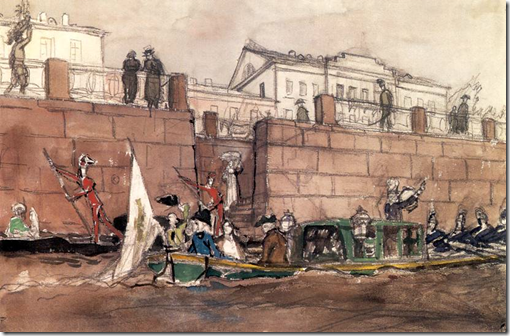
He worked no less fruitfully as an art historian: he published in two editions (1901, 1902) the widely known book Russian Painting in the 19th Century, substantially reworking his earlier essay for it; began to publish serial publications "Russian School of Painting" and "History of Painting of All Times and Peoples" (1910-17; the publication was interrupted with the beginning of the revolution) and the magazine "Art Treasures of Russia"; created a wonderful "Guide to the Hermitage Art Gallery" (1911).
Peterhof. Big cascade. 1901-17
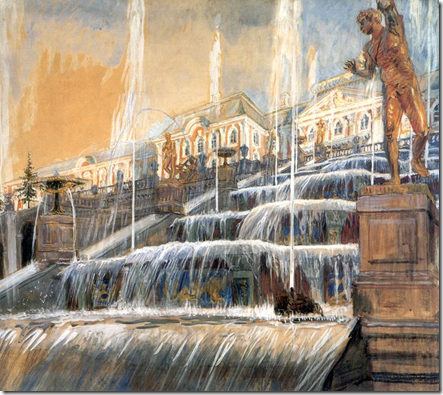
Quay Rei in Basel in the rain. 1902
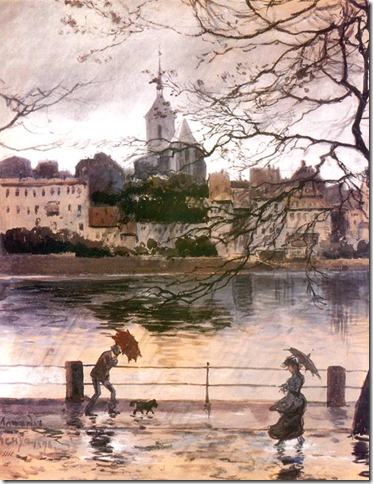
Summer garden under Peter the Great. 1902

Oranienbaum. Japanese garden. 1902
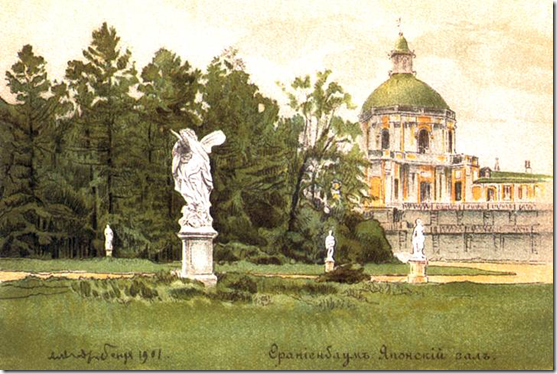
From the fantasy world. 1904
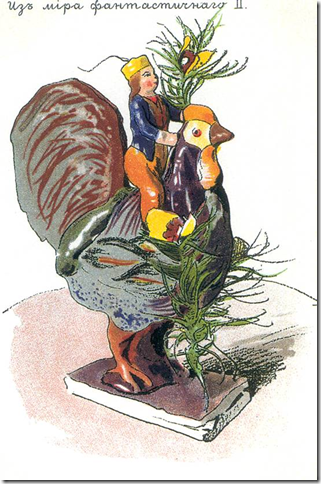
Pavilion. 1906

Marquise bath. 1906
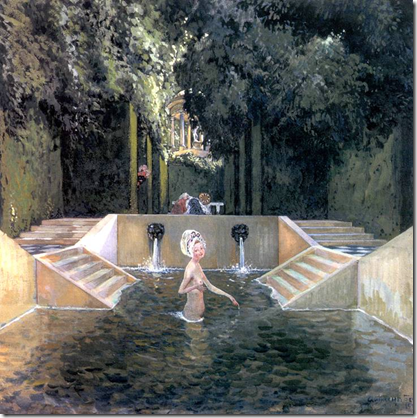
Wedding walk. 1906
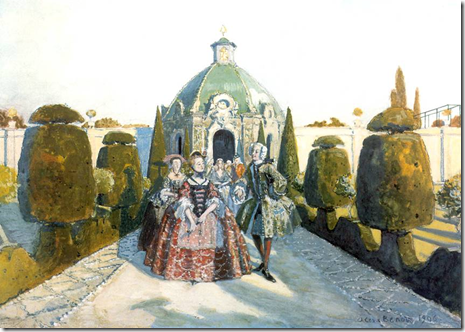
In the work of Benois the artist, history decisively prevailed. Two topics invariably attracted his attention: "Petersburg in the 18th - early 19th centuries." and "The France of Louis XIV". He addressed them primarily in his historical compositions - in two "Versailles series" (1897, 1905-06), in the well-known paintings "Parade under Paul I" (1907)
Parade under Pavel 1. 1907
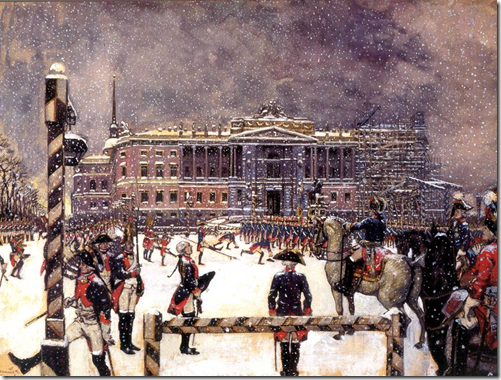
One of his highest achievements was the scenery for I. F. Stravinsky's ballet "Petrushka" (1911). Soon, Benois began working with the Moscow Art Theater, where he successfully designed two performances based on the plays of J.-B. Moliere (1913) and for some time even participated in the management of the theater along with K. S. Stanislavsky and V. I. Nemirovich-Danchenko.
Italian comedy. "Love Note". 1907
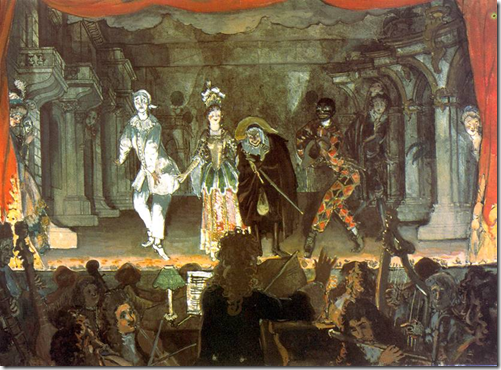
Berta (costume sketch by V. Komissarzhevskaya). 1907

Evening. 1905-06
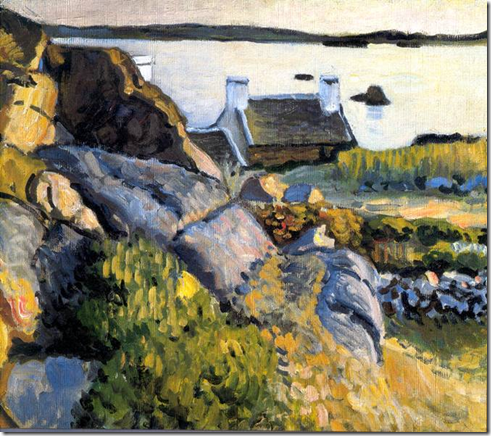
After the revolution of 1917, Benois took an active part in the work of various organizations connected mainly with the protection of monuments of art and antiquity, and from 1918 he also took up museum work - he became the head of art gallery Hermitage. He developed and successfully implemented a completely new plan general, museum exposition, which contributed to the most expressive demonstration of each work.
At the beginning of the XX century. Benois illustrates the works of Pushkin A.S. Acts as a critic and art historian. In the 1910s, people came to the center of the artist's interests.
Herman in front of the windows of the Countess (screen saver for Pushkin's The Queen of Spades). 1911

The artist entered the history of Russian book graphics with his book "ABC in the paintings of Alexander Benois" (1905) and illustrations for "The Queen of Spades" by A. S. Pushkin, performed in two versions (1899, 1910), as well as wonderful illustrations for "The Bronze Horseman" ", to the three variants of which he devoted almost twenty years of work (1903-22).
illustration for Pushkin's poem "The Bronze Horseman". 1904
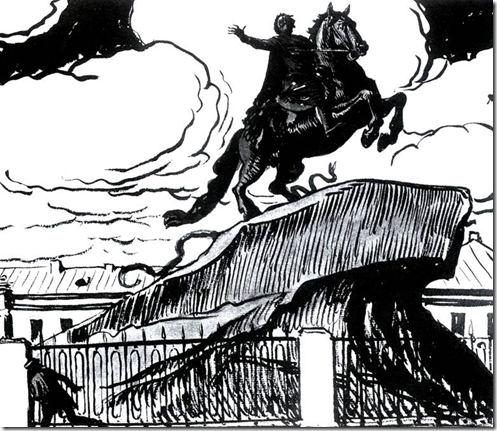
Frontispiece sketch for A. S. Pushkin's poem "The Bronze Horseman"
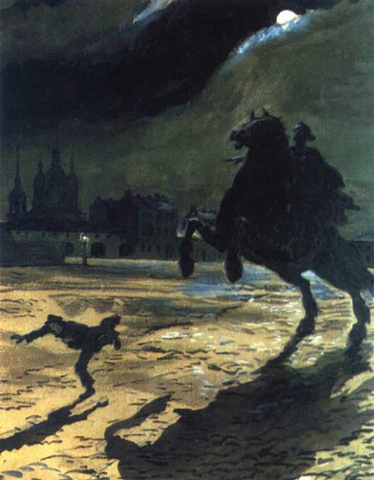
By the end of the 19th and beginning of the 20th century, Benois again returns to the landscapes of Peterhof, Oranienbaum, Pavlovsk. It glorifies the beauty and grandeur of 18th century architecture. Nature interests the artist mainly in its connection with history. Possessing a pedagogical gift and erudition, he at the end of the 19th century. organized the "World of Art" association, becoming its theorist and inspirer. He worked a lot in book graphics. He often appeared in the press and every week published his "Artistic Letters" (1908-16) in the newspaper "Rech".
Benois Alexander Nikolaevich (1870–1960), Russian artist, theatrical figure, art historian and critic; founder of the association "World of Art".
Born in St. Petersburg on April 21 (May 3), 1870 in the family of the famous architect N.L. Benois. He studied at the St. Petersburg Academy of Arts (1887), but received his basic painting skills from his brother Albert, a watercolorist and architect. A brilliant erudite and social activist, he was the main initiator of the creation of the magazine "World of Art" (since 1898), and then the circle of artists of the same name.
No matter what nonsense the contemporary artistic hacks may talk about me, about my "aestheticism," my sympathies have drawn and now draw me to the simplest and most faithful depictions of reality.
Benois Alexander Nikolaevich
Being in romantic opposition to modernity, he was inspired by antiquity, drawing subjects for his watercolors and gouaches mainly in the 18th century. During frequent trips to France, he created a large melancholic and grotesque watercolor series The Last Walks of Louis XIV (1897–1898), which established him as the “singer of Versailles”. Subtle poetic historicism marked his images of Russian history and literature (gouaches for the publication Russian History in Pictures, 1907–1910; illustrations for the Queen of Spades, 1899 and 1910, and the Bronze Horseman, 1903–1922, by A.S. Pushkin). See also BENOIT.
In 1894, Benois made his first appearance as an art historian, writing a chapter on Russian artists for the German edition of R. Muther's History of Painting in the 19th century (1894). He was the author of the History of Russian Painting in the 19th Century (1902), the Russian School of Painting (in 10 issues, 1904-1906) and the History of Painting of All Times and Peoples (in 4 volumes, 1912-1917; the publication is not completed). He founded and edited the journal "Art Treasures of Russia" (1901-1903), actively collaborated in the magazines "Old Years", "Moscow Weekly", the newspapers "Slovo" and "Rech" (his Artistic letters in the cadet "Rech", 1908 are especially significant –1917).
For the first time, as a historian, substantiating the national identity and international relations of Russian art of modern times on such a large scale, Benois, as a critic-publicist, expressed concern about the absence of the classical “grand style” of modernity, and fought against vandalism in relation to ancient monuments.
From 1907 he worked as a stage designer, primarily for M.M. Fokin (Mariinsky Theatre), as well as S.P. Diaghilev (in 1909–1911 he was the artistic director of the Russian Seasons). In his scenography (N.N. Cherepnin’s ballet The Pavilion of Armida at the Mariinsky, 1907; I.F. Stravinsky’s Petrushka at the Chatelet Theater in Paris, 1911; and others), he continued the tradition of the “picturesque theater”, giving it an unprecedented dramatic edge. In 1913–1915 he was the chief artist of the Moscow Art Theater; staged several productions together with K.S. Stanislavsky and V.I.
After February Revolution 1917 first actively involved in the reform of cultural life and museum work (in 1918 he headed the Hermitage Art Gallery, publishing its new catalog), still acted as a book and theater artist, participated in exhibitions. In 1926, not returning from another business trip, he settled in Paris.
True to the historical and romantic style of the World of Art, he fruitfully collaborated with theaters different countries the world, including with the Paris Opera (1927-1934) and the Milan theater "La Scala" (1947-1956); as a critic continued his Art Letters in the Latest News newspaper (1930–1936). Wrote My Memoirs (1955), subtly recreating the atmosphere of the Russian " silver age».
Alexander Nikolaevich Benois - photo
Self-portrait 1896 (paper, ink, pen)
Biography of Alexandre Benois
Benois Alexander Nikolaevich(1870-1960) graphic artist, painter, theater artist, publisher, writer, one of the authors of the modern image of the book. Representative of Russian modernity.
A. N. Benois was born into the family of a famous architect and grew up in an atmosphere of reverence for art, but did not receive an art education. He studied at the Faculty of Law of St. Petersburg University (1890-94), but at the same time independently studied the history of art and was engaged in drawing and painting (mainly watercolor). He did this so thoroughly that he managed to write a chapter on Russian art for the third volume of "The History of Painting in the 19th Century" by R. Muther, published in 1894.
They immediately started talking about him as a talented art critic who turned over the established ideas about the development of domestic art. In 1897, based on impressions from trips to France, he created the first serious work - a series of watercolors "The Last Walks of Louis XIV", - showing himself in it as an original artist.
On May 3 (April 21, O.S.), 1870, Alexander Nikolaevich Benois was born - a Russian artist, art historian, art critic, museum worker, founder and main ideologist of the World of Art association.
If M.V. Lomonosov belongs to the glory of the first Russian scientist-encyclopedist, then A.N. Benois can certainly be called the first Russian "encyclopedist" of art. Painter and easel graphic artist, illustrator and book designer, master of theatrical scenery, director, author of ballet librettos, A.N. Benois was at the same time an outstanding historian of Russian and Western European art, a theorist and sharp publicist, an insightful critic, a major museum figure, an incomparable connoisseur of theater, music and choreography. All his biographers and contemporaries call the all-consuming love for art the main feature of Benois's character. The versatility of Alexander Nikolayevich's knowledge and activities served only as an expression of this love. Both in science and in art criticism, in every movement of his thought, Benois always remained an artist. Contemporaries saw in him a living embodiment of the spirit of artistry.
Family and early yearsAlexander Nikolaevich Benois was the ninth (and last) child in the family of academician of architecture Nikolai Leontyevich Benois and musician Camilla Albertovna (née Kavos). Alexander's maternal ancestors were Italians, his father's family moved to Russia after the revolutionary upheavals in France. For generations, art was a hereditary profession in his family. Benois' maternal great-grandfather K. A. Cavos was a composer and conductor, his grandfather was an architect who built a lot in St. Petersburg and Moscow; the artist's father was also a major architect, the elder brother was famous as a watercolor painter. Consciousness young Benoit developed in an atmosphere of artistic impressions and artistic interests.
Subsequently, recalling his childhood, the artist especially insistently emphasized two "spiritual jets", two categories of experiences that influenced the formation of his views and, in a certain sense, determined the direction of all his future activities.
The first and strongest of them is connected with theatrical impressions. From the earliest years and throughout his life, Benoit experienced a feeling that can hardly be called otherwise than the cult of the theater. From childhood, Benois associated the concept of "artistic" with the concept of "theatricality". His favorite toys were miniature scenery, paper figures of actors, which made up whole sets, with the help of which the boy could stage puppet shows on his own. Grandmother brought Alexandra from Venice real Italian puppets, depicting the heroes of the commedia dell'arte: Columbine, Harlequin, Pierrot ... It was in the art of the theater that the already adult A. Benois saw the only opportunity to create a creative synthesis of painting, architecture, music, plastic and poetry, to realize that organic fusion art, which seemed to him the highest goal artistic culture.
The second category of adolescent experiences, which left an indelible imprint on Benois's aesthetic views, arose from impressions from country residences and St. “From these ... Peterhof impressions, probably, my whole further cult of Peterhof, Tsarskoye Selo, Versailles came about,” the artist later recalled. The early impressions and experiences of Alexandre Benois go back to the origins of that bold reassessment of the art of the 18th century, which is one of greatest merit"World of Art".
It should be noted that the artistic tastes and views of the young Benois were formed in opposition to his family, which adhered to conservative "academic" views. The decision to become an artist matured in Alexander very early. He began to draw in a private kindergarten, and in 1885-1890, while studying at the private gymnasium of K.I. V. Nouvel, D. Filosofov (cousin of S.P. Diaghilev), L. Bakst. They organized a circle of art lovers.
In 1887, while still a high school student, Benois began attending classes at the Academy of Arts, which brought him nothing but disappointment. He preferred to get a legal education at St. Petersburg University (1890-1894), and to go through professional art training on his own, according to his own program. His older brother Albert, who successfully painted in watercolor, became his teacher.
Daily hard work, constant training in drawing from nature, the exercise of fantasy in working on compositions, combined with an in-depth study of art history, gave the artist a confident skill that is not inferior to the skill of his peers who studied at the Academy. With the same perseverance, Benois prepared for the work of an art historian, studying the Hermitage, studying special literature, traveling to historical cities and museums in Germany, Italy and France.
Self-study in painting (mainly watercolor) was not in vain, and in 1893 Benois first appeared as a landscape painter at the exhibition of the Russian "Society of Watercolors".
A year later, he made his debut as an art historian, publishing on German an essay on Russian art in Muther's book The History of Painting in the 19th Century, published in Munich. Russian translations of Benoit's essay were published in the same year in the magazines "Artist" and "Russian Art Archive". They immediately started talking about him as a talented art critic who turned over the established ideas about the development of domestic art.
Immediately declaring himself both a practitioner and a theoretician of art at the same time, Benois maintained this dual unity in subsequent years. His talent and energy was enough for everything.
In 1895-99, Alexander Benois was the keeper of the collection of modern European and Russian paintings and drawings of Princess M. K. Tenisheva. In 1896 he organized a small Russian department for the Secession exhibition in Munich; in the same year he made his first trip to Paris, painted views of Versailles, initiating his series on Versailles themes, which he loved so much throughout his life.
The series of watercolors "The Last Walks of Louis XIV" (1897-98, the Russian Museum and other collections), created on the basis of impressions from trips to France, was his first serious work in painting, in which he showed himself to be an original artist. This series for a long time approved for him the glory of "the singer of Versailles and Louis".
"World of Art"The circle of friends and like-minded people of Alexander Benois was formed, as already mentioned, back in the gymnasium and university years. In the late 1890s, a circle of young like-minded people was transformed into the World of Art society and the editors of the magazine of the same name. It was in the "World of Art" that they began their diverse activities worldwide famous artists Leon Bakst, Mstislav Dobuzhinsky, Evgeny Lansere, Igor Grabar. N. Roerich, M. Nesterov, K. Serov, M. Vrubel, M. Korovin, B. Kustodiev and other masters of Russian art of the early 20th century were closely associated with them.
Motivating the emergence of the "World of Art", Benoit wrote:
|
“We were guided not so much by considerations of an “ideological” order, as by considerations of practical necessity. A number of young artists had nowhere to go. They were either not accepted at all for large exhibitions - academic, traveling and watercolor, or they were accepted only with the rejection of everything in which the artists themselves saw the most clear expression of their quests ... And that's why Vrubel ended up next to Bakst, and Somov next with Malyavin. The "unrecognized" were joined by those of the "recognised" who felt uneasy in the approved groups. Mainly Levitan, Korovin and, to our greatest joy, Serov came up to us. Again, ideologically and in their entire culture, they belonged to a different circle, they were the last offspring of realism, not devoid of "wandering coloring." But they were connected with us by their hatred for everything stale, established, dead.” |
The history of the "World of Art" began with an exhibition of Russian and Finnish artists arranged by Sergei Diaghilev in January 1898 in the premises of the Baron Stieglitz's school in St. Petersburg. S.P. Diaghilev studied with Benois at the Faculty of Law, and later recalled:
The Russian-Finnish exhibition was a great success. The works of a number of strong representatives of the new trend in Russia were exhibited here for the first time. The exposition of the exhibition became the prototype for future exhibitions of the magazine "World of Art", it was here that their structure and composition of participants was outlined.
At the end of 1898, a group of like-minded artists Benois created the magazine "World of Art", which became the herald of neo-romanticism. In the future, annual exhibitions of the association are held.
The program of the "World of Art" assumed the invasion of its figures in all areas of culture, including not only fine arts, theater, book design, but also the creation of household items - furniture, applied art, interior design projects. In this regard, the World of Arts undoubtedly focused on the creation of a large artistic style, which is confirmed by their participation, led by Alexander Benois, in the work on the sketches of the mural of the largest public building of that time - the Kazan railway station. The work of the artists of the "World of Art" was marked by the seal of intimacy, refined aestheticism and gravitation towards graphics. However, intimacy and the desire for "art for the sake of art itself" are inherent in almost all artistic and literary communities. late XIX-beginning of XX century. The slogan "art for the masses" had not yet been proclaimed, and the future proletarian poets and artists were still busy with other things...
Alexandre Benois, having become the ideologist and theorist of the World of Art association, actively participated in its artistic life, as well as in the publication of the World of Art magazine, which assumed the role of the basis and ideological mouthpiece of this association. Benois often appeared in the press and every week published his "Art Letters" (1908-16) in the newspaper "Rech". He worked even more fruitfully as an art historian: he published in two editions (1901, 1902) the book Russian Painting in the 19th Century, substantially reworking his earlier essay for it. Since 1910, he began to produce serial publications "Russian School of Painting" and "History of Painting of All Times and Peoples" (the publication was interrupted only with the beginning of the revolution in 1917). In the same years, under the editorship of Benois, the illustrated magazine Artistic Treasures of Russia was published. In 1911, he created a wonderful Guide to the Hermitage Art Gallery.
"Singer of Versailles": landscape painterBenois began his career as a landscape painter and throughout his life he painted landscapes, mostly watercolors. They make up almost half of his legacy. The very appeal to the landscape in Benoit was dictated by an interest in history. Two topics invariably attracted his attention: "Petersburg in the 18th - early 19th centuries." and "The France of Louis XIV".
Later, in his memoirs, written in old age, Benoit admitted:
|
“In me, “passeism” began to manifest itself as something completely natural even in early childhood, and it remained throughout my life “the language in which it is easier, more convenient for me to express myself” ... Much in the past seems to me well and long familiar, perhaps even more familiar than the present. To draw, without resorting to documents, some contemporary of Louis XV is easier for me, easier for me than to draw, without resorting to nature, my own contemporary. I have a more tender, more loving attitude towards the past than towards the present. I better understand the thoughts of that time, the ideals of that time, dreams, passions, and even the most grimaces and whims, than I understand all this in the "plan of modernity" ... " |
(A. Benois. The life of an artist, vol. I.)
His first independent work(1892-1895) are a series of images of Pavlovsk, Peterhof, Tsarskoye Selo, corners of old St. Petersburg, as well as cities in Germany and Switzerland, their ancient quarters and architectural monuments. Later, already a mature master, Benois performed a series of landscapes of Versailles, to which he returned many times (1896, 1897, 1898, 1905, 1906, 1907, 1914), Peterhof (1900), Oranienbaum (1901), Pavlovsk (1902), Rome ( 1903), Venice (1912). All these series are dominated by images of historical sites, palace parks and works of art. Nature interested the artist mainly in its connection with history. Only later, among the works of 1911-1916, purely landscape cycles of watercolors began to appear, depicting the nature of Italy, Switzerland and the Crimea.
A significant part of these series are works from nature. For the most part, these are conscientious and accurate sketches, not brilliant in technique and not always possessing great artistic expressiveness. But for Benois, natural studies were only the initial stage of creativity. The material drawn from direct observations was subjected to further cardinal processing. The artist rebuilt the composition, changed the proportions, enhanced the decorative sound of color, turning the real landscape into a kind of theatrical scenery with wings, a backdrop and a stage platform on which action can be played, and sometimes the action is played.
The main features of Benois's Versailles watercolors come from examples of architectural and landscape engravings: their clear, almost drawing-like layout, clear spatiality, the predominance of simple, always balanced horizontals and verticals, the grandeur and chilly severity of compositional rhythms, and finally, the emphasized opposition of the grandiose statues and sculptural groups of Versailles - small, almost stuffed figurines of the king and courtiers, playing simple genre-historical scenes. In Benois's watercolors there is no dramatic plot, no active action and psychological characteristics of the characters. The artist is not interested in people, but only in the atmosphere of antiquity and the spirit of theatrical court etiquette.
Following the first Versailles series, Benois created three series of landscapes and interiors depicting the domestic "Versailles" - Peterhof, Oranienbaum and Pavlovsk.
In these series there are no historical-genre scenes, no images of people, and therefore there is no shade of lyrical irony, which marked the Last Walks of Louis XIV. All three new series were written as a result of a thorough historical and artistic research, inspired by a passionate passion for poetry. Depicting the palaces and parks of suburban royal residences, Benois pathetically glorifies the beauty and grandeur of Russian art of the 18th century. In Benois's compositions, the features of the theatrical "stage" construction are often preserved, although historical characters do not perform on the stage. The “hero” of the artist’s new works is the very art of the past: not people, but magnificent architectural and park ensembles, sometimes striking in their grandiosity, sometimes charming with intimate grace and poetic charm.
At the beginning of 1905, Benoit and his family traveled to France again. Being, in his own words, organically alien to politics, the artist hoped that with education State Duma all "ugliness" in Russia will end. He did not at all share the revolutionary sentiments of his comrades in the "World of Art" - E. Lansere, D. Filosofov and his friends - Merezhkovsky and Gippius. The artist himself admitted that it is difficult to call him a patriot. He always tried to get away from the terrible changes in his homeland, leaving the country or completely leaving for creativity.
In France, in 1905-1906, the famous second "Versailles" Benois series was created. It is much more extensive than The Last Walks of Louis XIV and is more diverse in content and technique. It includes sketches from nature painted in the Versailles park, retrospective historical and genre paintings, original "fantasies" on architectural and landscape themes, images of court theater performances in Versailles. The series includes works in oils, tempera, gouache and watercolor, drawings in sanguine and sepia.
However, these works can only conditionally be called a "series". They are connected with each other not by the development of the plot and not even by the commonality of the creative tasks set in them, but only by a certain unity of mood that prevailed at a time when Benoit, in his words, was "drunk with Versailles" and "completely moved into the past", striving forget about the tragic Russian reality of 1905.
The same series includes works that are among the most successful works of Benois, deservedly widely known: “Parade under Paul I” (1907, State Russian Museum; p. 401), “Exit of Empress Catherine II in Tsarskoye Selo Palace” (1909 , State Art Gallery of Armenia, Yerevan), "Petersburg Street under Peter I" (1910, private collection in Moscow) and "Peter I on a walk in the Summer Garden" (1910, State Russian Museum). In these works one can notice some change in the very principle of the artist's historical thinking. Finally, not monuments of ancient art, not things and costumes, but people, fall into the center of his interests. The multi-figure historical and everyday scenes painted by Benois recreate the appearance of a past life, seen as if through the eyes of a contemporary.
theater artistBenois gave a lot of mental strength and time to work in easel painting and graphics, but by the very nature of his talent and warehouse creative thinking he was not an easel painter, and even less a master of a painting that could embody all aspects of his idea in a single, as it were, synthesizing image. Benois thought and approached his subjects precisely as an illustrator or as a theater artist and director, successively revealing various aspects of the image he had conceived in a cycle of studies and compositions, creating a series of successive architectural and landscape scenery and carefully designed mise-en-scenes. No wonder it best creatures belong to the art of the book and the painting of the theatre.
The theater was during the whole life of Benois his strongest passion; nothing he loved so ardently and knew so deeply. Having proved himself in many genres - in literature, painting, art history, criticism, directing - Alexandre Benois is remembered, first of all, as a theater artist and theorist of theatrical and decorative art.
From his mother, Benois inherited a genuine cult of the theater, and his childhood dream was to become a theater artist. A true child of St. Petersburg in the 1870s and 80s, Benois was deeply engrossed in his then passion for drama, opera and ballet, and even before his trip to Germany in 1890 he saw Sleeping Beauty, The Queen of Spades and many other performances. Benois made his debut as a theater artist in 1900, designing A.S. Taneyev's one-act opera The Revenge of Cupid at the Hermitage Theater in St. Petersburg.
In 1901, Prince S. M. Volkonsky, director of the Imperial Theatres, succumbing to the persuasion of S. P. Diaghilev, decided to prepare a special production under his direction of Delibes' one-act ballet Sylvia. Benois was invited as the chief artist and worked on the performance together with K.A. Korovin, L.S. Bakst, E.E. Lansere and V. A. Serov, however, due to a quarrel between Diaghilev and Volkonsky, the ballet was never staged.
Benois' real debut as a theater artist took place in 1902, when he was commissioned to stage the production of R. Wagner's opera The Death of the Gods on the stage of the Mariinsky Theatre. After that, he performed sketches for the scenery for N. V. Tcherepnin's ballet The Pavilion of Armida (1903). The artist himself composed the libretto and, together with the choreographer M. Fokin, participated in the production of this performance.
The success of Benois in the "Pavilion of Armida" only confirmed his artistic vocation. He was immediately involved in many theatrical projects. In 1907 A.N. Benois played an important role in the founding of the Old Theater in St. Petersburg (for which he created a curtain), the following year one of its scenery was used in the Paris production of Boris Godunov.
The passion for ballet turned out to be so strong that on the initiative of Benois and with his direct participation, a private ballet troupe was organized, which began triumphant performances in Paris in 1909 - "Russian Seasons". They are usually associated only with the name of S.P. Diaghilev, forgetting that it was A.N. Benois served as artistic director in the troupe. It was his production of The Pavilion of Armida that marked the beginning of the Diaghilev Seasons in Paris in 1909. The role of Benois in ballet productions, as well as in the design of performances, is much more significant than the role of his friend Diaghilev. Diaghilev, by and large, was only a talented administrator with a good, speaking modern language, "administrative resource": connections, acquaintances, access to public funding.
For the "Russian Seasons" in Paris, Benois also designed the performances of "Selfida" (1909), "Giselle" (1910), "The Nightingale" (1914). One of the highest achievements of the theater artist Benois was the scenery for I. F. Stravinsky's ballet "Petrushka" (1911). It should be noted that this famous ballet was created according to the idea of Benois himself and according to the libretto written by him.
Soon, the artist's cooperation with the Moscow Art Theater was born, where he successfully designed two performances based on the plays of J.-B. Molière (1913). From 1913 to 1915 A.N. Benois actively participated in the management of the theater along with K. S. Stanislavsky and V. I. Nemirovich-Danchenko.
In the last pre-revolutionary years (1911-1917), Benois, who was mainly engaged in work in the theater, continued from time to time to turn to easel painting and graphics. In 1912, a series of landscapes of Venice was created, in 1915 - a Crimean series. In 1914-1917, the artist worked on sketches for decorative panels for the Kazansky railway station in Moscow, which, however, were never implemented.
book artistTogether with other masters of the World of Art, Benois was one of the most active figures in the art movement that revived the art of book graphics in Russia.
Almost every artist of the "World of Art" left his mark on the development of new book graphics and participated in one way or another in the creation and development of a common creative system of illustration and book design; but, of course, the share of participation was not equal for everyone. Somov was the initiator and founder of new artistic principles for the decorative decoration of the book, but he did not have the talent of an illustrator.
Like Somov, Benois performed a number of purely design, decorative drawings for the magazines World of Art (1901, 1902, 1903), Artistic Treasures of Russia (1902) and Golden Fleece (1906). But the main area of his activity in graphics, starting from early period and until the last pre-revolutionary years, there was illustration.
Among Benois' early works for the book is an illustration for The Queen of Spades (1898), published in the three-volume collection of Pushkin's works (1899), illustrated by many Russian artists, including the masters of the World of Art. This first experience was followed by four watercolors - illustrations for The Golden Pot by E. T. A. Hoffmann (1899), which remained unpublished, and two page illustrations for the book by P. I. Kutepov "Royal and Imperial Hunting in Russia" (1902) created in collaboration with EE Lansere. Already in these early works, the specific features of Benoit's illustrative talent are clearly visible: the power of his imagination, plot ingenuity, the ability to convey the spirit and style of the depicted era. But the illustrations are still "easel" in nature: these are historical compositions built into the book, not organically merging with it.
A more mature phase in the development of Benois's book graphics reflects his ABC in Pictures (1904) - the first book in which the artist acted as the sole author, creator of the idea, illustrator and designer. It was the first time he had to deal with issues here. artistic design books. Each of the drawings for the "ABC" is a detailed narrative scene, imbued with mild humor, sometimes genre, more often fairy-tale or theatrical, always inexhaustibly inventive in terms of plot motives. The history of the children's book "The World of Art" begins with the "ABC" of A. Benois.
Gradually book graphics in hands of Benoit becomes art not so much decorative as narrative. Purely design tasks, which so occupied Somov, Dobuzhinsky and the young Lansere, play a clearly secondary role in the work of Benois. His compositions are always spatial precisely because they are, first of all, narrative.
The main place among the graphic works of Benois is occupied by illustrations for the works of A.S. Pushkin. The artist worked on them throughout his life. As already mentioned, he began with drawings for The Queen of Spades (1898) and then returned to illustrating this story twice (in 1905 and 1910). Benois also made two series of illustrations for The Captain's Daughter and for a number of years prepared his main work - drawings for The Bronze Horseman.
In pre-revolutionary times, Benois' book works had little success with publishers. The drawings for The Captain's Daughter (1904) remained unpublished. The first version of the illustrations for The Bronze Horseman (1903) was not published as a separate book, but only in the journal World of Art (1904), in violation of the design layout conceived by the artist. Only the second version (1910) of illustrations for The Queen of Spades was properly published.
The best of the artist's book works, of course, is his masterpiece - drawings for Pushkin's The Bronze Horseman. The cycle of the first version consists of 32 ink and watercolor drawings imitating colored woodcuts. The publication of illustrations in the "World of Art" was immediately greeted by the artistic community as big event in Russian graphics. I. Grabar noted in Benois's illustrations a subtle understanding of Pushkin and his era and, at the same time, a heightened sense of modernity, and L. Bakst called the series of illustrations for The Bronze Horseman "a real pearl in Russian art."
Completely all of Benois's illustrations for The Bronze Horseman were published only in the 1920s.
Benois - art historianBenois' activities as an art critic and art historian are inextricably linked with everything that Benois did in painting, easel and book graphics, and in the theater. Critical essays and historical and artistic studies of Benois are a commentary on the ideological and creative searches and everyday practical work artist. His literary works, undoubtedly, have an independent significance, characterizing a complex, large and fruitful stage in the development of Russian criticism and the science of art.
Together with Grabar, Benois led a movement that updated the method, techniques and themes of Russian art history in the late 19th and early 20th centuries. One of the most important missions of this movement, which arose in line with the World of Art, was a systematic review of all material, critical assessments and main problems in the history of Russian painting, architecture, plastic arts and decorative and applied arts of the 18th and 19th centuries. The idea was to shed light on the processes of development of Russian artistic culture over the past two centuries in a new way, drawing on materials not only previously unstudied, but also almost untouched.
It is difficult to overestimate the scale of this work, which could only be collective. It was attended by almost all the figures of the "World of Art". Artists and critics, following the example of Benois, became historians, collectors, discoverers and interpreters of forgotten or incomprehensible artistic values. We have already mentioned the significance of such "discoveries" as Russian portraiture of the 18th century and the architecture of old Petersburg. Many such discoveries were made by the World of Arts in the most diverse areas of artistic culture. Benois was the initiator and inspirer of this work. The most difficult, responsible part of it also fell to his lot - the analysis and generalization of the history of Russian painting of the 18th-19th centuries.
In 1901-1902, the History of Painting in the 19th Century was published in two parts. Russian Painting”, attached as the fourth volume to the translation of the famous work of R. Muter. The title of Benois's book does not fully correspond to its content: the presentation covers not only the 19th century, but the entire history of new Russian painting, from the Petrine era to the first exhibitions of the World of Art.
In the domestic scientific literature questions of the history of art have never before been presented with such completeness and systematicity, with such insightful analysis and, at the same time, with such emphatic and even programmatic subjectivity. Benoit's book is a serious and original study, striking in the abundance and variety of material involved, deep thoughtfulness and penetrating subtlety of individual characteristics, but ... At the same time, the book is a sharp journalistic treatise, polemically directed against academism and wanderers. In his book, Benois gave a devastating description of the work of Bryullov and Bruni, spoke with disdain about Aivazovsky and Vereshchagin, and showed unfair intolerance towards many Wanderers. At the same time, he often exaggerated the significance of the work of his closest associates and friends.
These features of the book are connected with the group tactics of the "World of Art" and with the personal, subjective predilections of the author. Representing a tribute to the times, they should not play a decisive role in the evaluation of Benoit's work. A much more tangible shortcoming of the book is the precariousness and vagueness of the general historical concept underlying the study. It lacks historicism. Art is interpreted by Benois as a completely autonomous sphere, independent of social reality and hardly connected with other cultural phenomena. Thus, the topic of research is not the process historical development national painting with its hidden patterns to be discovered, but only the history of the artists who took part in this process.
But if the history of Russian painting as a whole contains serious shortcomings, then its individual pages, in which the author was not shackled by predilections of personal taste or tactical considerations of the group, are among the most striking phenomena of Russian art history at the beginning of the 20th century. To this day, the chapters on portrait painters of the 18th century, on Kiprensky, Venetsianov, Sylvester, Shchedrin and landscape painters of the 1810-1830s, on Alexander Ivanov, Surikov, Vrubel and Serov retain their scientific significance.
Simultaneously with these major works, Benois published in the journal "World of Art" (1899-1904) and the monthly collection "Artistic Treasures of Russia" (1901-1903), and later in the journal "Old Years" (1907-1913) and some other publications, many articles and notes on certain issues of the history of Russian and Western European art. The most significant articles concern the architecture of old St. Petersburg and its suburbs. In 1910, an extensive study by Benois "Tsarskoe Selo in the reign of Empress Elizabeth Petrovna" was published - a thoroughly documented work on the history of everyday life and artistic life in Russia in the first half of the 18th century.
Benois - art criticThe earliest of Benoit's art-critical series, The Artist's Conversations, published in the World of Art magazine in 1899, characterizes Benoit's first steps as a critic. It contains mainly reviews of Parisian art exhibitions and notes on some minor French painters like Forain and Latouche, who at that time still seemed to the critics more significant than the Impressionists and Cezanne.
The second series of his articles, published in the "Moscow Weekly" for 1907-1908 under the heading "The Diary of an Artist", is devoted mainly to issues of theater and music.
The heyday of Benois' artistic and critical activity falls on the period of the creation of the third series of his articles - under the general title "Art Letters", which were published weekly in the newspaper "Rech" from November 1908 to 1917. This series includes about 250 articles, unusually diverse in content and, on the whole, reflecting the artistic life of those years with great completeness. Not a single significant event in art remained without a response from Benois. He wrote about modern painting, sculpture and graphics, about architecture, theater, about ancient art, folk art, about new books and exhibitions, about creative groups and individual masters, analyzing and evaluating every major art phenomenon with passionate interest. According to Benois, only freedom and inspiration create and condition value. artwork. But the critic emphasizes that the freedom of art is not unlimited, and inspiration should not escape the control of consciousness. There is no place for arbitrariness in art, and the most important quality of an artist is a sense of professional responsibility.
After the disasterAT national historiography there is an opinion that “Alexander Benois, like Blok, Bely and Bryusov, supported the October Revolution and, with his usual zeal, worked as a curator of works visual arts in his native Petersburg. It would be more accurate to say that A.N. Benoit with all his might tried to work with the usual diligence, despite the catastrophic changes that have taken place in the country. But politics itself constantly intruded into the life of a person who had neither certain political convictions nor the desire to stand up in open opposition to any kind of authority.
During the years of revolution and civil war A.N. Benois remained in Petrograd. The Bolsheviks, having barely seized power, declared “war on the palaces”, and the guardian of the national art actively took up the problems of reorganizing the palace complexes, as well as preserving these monuments of national culture from vandalism and looting. Judging by the diaries of Benois for the period 1917-1920, the reality of the first post-revolutionary years seriously frightened the artist, but he refused to emigrate and did not leave his homeland at such a decisive hour. However, hunger, cold, an abundance of garbage, military cripples and "intelligent" beggars on the streets of Petrograd did not fit into Benois's ideas about life in general, and about the life of his family in particular. The Benois family managed to survive during these years only thanks to American ARA rations (aid to affected countries in the First World War). From 1917 to 1926, Benois was in charge of the Art Gallery of the Hermitage, i.e. was a civil servant to whom these rations were issued as wages.
In 1921, two brothers A.N. were arrested. Benois - Leonty and Mikhail. And he himself lived with a constant fear of being arrested.
"Sleepless night due to incessant listening,- he wrote in his diary on August 7, 1921 - Akita(wife of A.N. Benois - E.Sh.) it doesn’t allow the window to be closed for fresh air, and therefore you can hear everything, how the latch of the gate clicks in the gate, how they walk around the yard, and it all seems that the Arkharovites will appear: here they are heading to our floor ... "
Over time, fear became something ordinary and turned into a feeling of incessant vague anxiety. “Now I feel more tired, broken and dejected than in all these years. It feels like something is hanging over your head,- wrote A.N. Benois already in April 1923. He called such emotions "a feeling of the OGPU", as well as "a common disease in Russia." The fear of speaking out openly on issues of art and culture close to him, fearing that the people with whom you are talking will turn out to be provocateurs, constantly pursued Alexandre Benois. And he, being an uncompromising critic before the revolution, not afraid to speak out on any artistic issues, was now forced to choose his words even in conversations with good acquaintances.
The only consolation in the often simply unbearable reality for Alexander Benois during these years was the Hermitage. With extraordinary zeal, he put together new exhibitions, searched for masterpieces worthy of the Hermitage from the expropriated collections. But here, before A.N. Benois faces constant obstacles of a completely different kind: from the fact that the Hermitage is cut off electricity for non-payment and ending with difficulties in hanging paintings, as well as constant threats of sales of the Hermitage valuables from the People's Commissariat of Education. A.N. Benois approached his work in the Hermitage with great responsibility, which he loved from childhood and dreamed of turning into a world-class museum. “It will be good if, thanks to me, the Winter Palace will be saved and turned into a monument-treasury global importance», he sincerely hoped.
However, this task was largely hampered by the general crisis in the artistic life of Russia. "Unfortunately, - Alexander Benois noted, - ... interest in art is falling, and in the very near future, he, and now barely vegetating, will have absolutely nothing to do." Art in Russia, according to A.N. Benois, was simply strangled by "decrees, alliances, the frivolity of Lunacharsky and the stupidity of other doctrinaires ..."
But even with the Bolsheviks A.N. Benoit could get along quite well (which is what he tried to do since 1917), if they gave him the opportunity to calmly do what he loves. But everyday obstacles constantly stood in his way: he had to take care of the well-being of the family, constantly bypass the obstacles placed by the government on artists (for example, the ban on painting on the streets of Petrograd). The most difficult thing for Alexandre Benois was that he was invariably required to express his political position. For him, a man who always proclaimed that he had no political convictions, this was unbearable. For some time he tried to live in the old way, carefully choosing his words in conversations with acquaintances, courageously enduring conversations about contemporary art with strangers, each of whom could turn out to be an informer or an agent of the Cheka-OGPU. However, in the USSR it was impossible to live outside of politics. Feeling this, A.N. Benois began to think about emigration.
Emigrant defectorIn the 1920s, Benois returned to his theatrical activities. He is working on the design of performances in the Petrograd theaters (the former Mariinsky and Alexandrinsky), trying to "fit" into the new, revolutionary art, but Soviet agitation is more likely to offend the feelings of the artist than to inspire him to creative achievements.
Staying in Soviet Russia, Benois never severed his ties with Europe, in particular with the Parisian Grand Opera, in whose productions he participated as a theater artist back in the pre-revolutionary years. Since 1923, Alexander Nikolaevich often travels on business trips to France, where he still works on the design of opera and ballet performances. The temptation to stay abroad was great, but the fear of forever breaking away from his native soil, being a "refugee" without certain occupations, stopped the artist for several years. In addition, the wife of Alexander Nikolaevich, Anna Karlovna Kind, a faithful companion of his whole life, categorically objected to emigration, considering it inappropriate to leave his native nest in old age.
It is possible that A.N. Benois, in order to be able to leave the country, bound himself with some obligations to the INO OGPU. In his surviving diaries and correspondence for 1923-25, the fear of refugee and lack of demand in a foreign land is quickly replaced by the fear of looking like an agent of the Bolsheviks in the eyes of the emigre public. In some records, the reluctance to meet with their former acquaintances and compatriots is clearly traced. “Perhaps those Russians won’t be there!”- wrote A. Benois in his diary before the next trip abroad. However, there are no direct indications of the artist's collaboration with the Chekists in known documents, and this issue remains unclear.
It wasn't until 1926 that Benois finally made the forced choice between the hardships of an emigre existence and the increasingly frightening prospect of living in a Soviet country. He once again left for Paris to stage and stage a performance at the Grand Opera, but never returned to Russia from there. This decision was not easy for Benoit. In the correspondence of 1926-27, the artist often notices that, as he manages to win back those positions in Europe that he lost during the years of the revolution, he is drawn back to his homeland: “And just imagine now, when I become completely my own person here, it begins to pull me home with unbearable force ...”(from a letter to F.F. Notgaft, 1926)
But A.N. Benoit, like most emigrants, not just in his homeland, but in the way he knew it before. That is why the longing for Russia, reflected in the epistolary heritage of Alexander Benois of the foreign period, is combined with his understanding that it is impossible to return there, just as it is impossible for a person to return to his long-gone childhood and youth.
Nevertheless, in France, Alexander Nikolayevich successfully continued his activities as a theater artist: first at the Grand Opera in Paris, then in the 1930s-1950s he collaborated with La Scala in Milan, where his son was in charge of the production Nikolay. Working on the former professional level, nothing fundamentally new and interesting Benoit he could no longer create, often content with varying the old one (at least eight versions of the ballet Petrushka, which became legendary, were performed).
The main labor recent years life were his memoirs, on the pages of which Benoit resurrects in detail and fascinatingly the years of his childhood and youth. In his memoirs My Memoirs, Benois penetratingly recreated the atmosphere of the spiritual and creative quests of the Silver Age in Russia at the turn of the 19th and 20th centuries.
Alexander Nikolaevich Benois died on February 9, 1960 in Paris, only a few months before his ninetieth birthday.
Throughout his long journey as an artist, critic and art historian, Benois remained true to the high understanding of aesthetic criteria in art, defended the inherent value of artistic creativity and fine art based on strong traditions. It is also important that all of Benois' multifaceted activities were, in fact, devoted to one goal: the glorification of Russian art. Throughout his long life, he did not step back from her a single step.
Compilation by Elena Shirokova based on materials:
A.N. Benois and his addressees./Comp. I.I. Vydrin. - St. Petersburg: Garden of Arts, 2003.
"In me, undoubtedly, sits ... a uniform archivist." From the diary of A.N. Benois (1923) / Publ. I.I. Vydrina // Domestic archives, 2001. No. 5. - P. 56-95.






